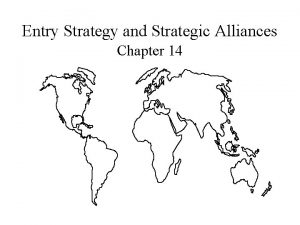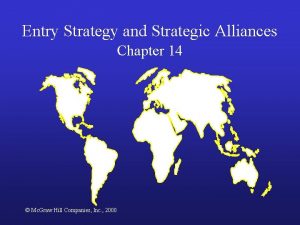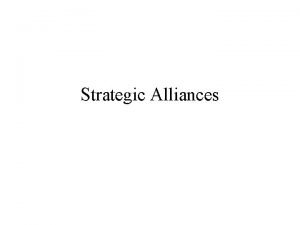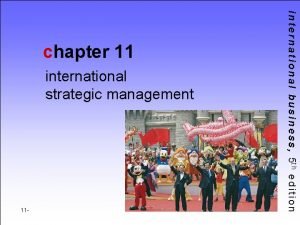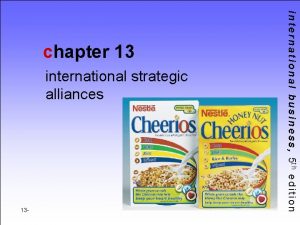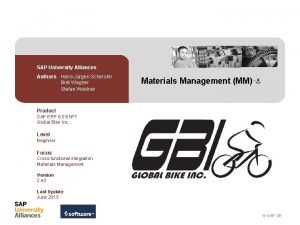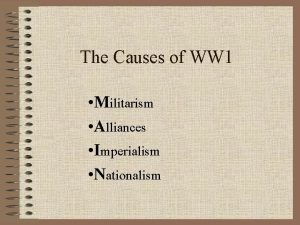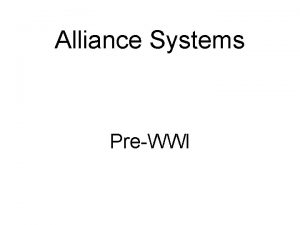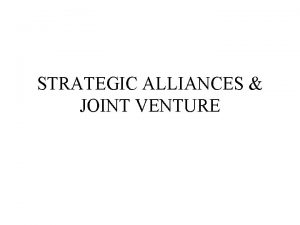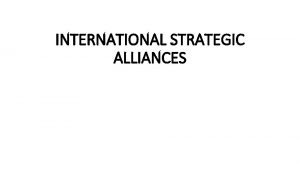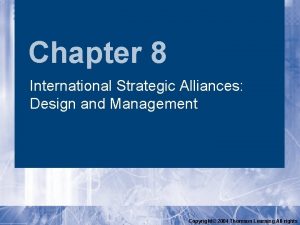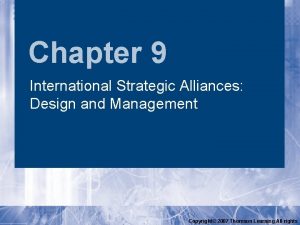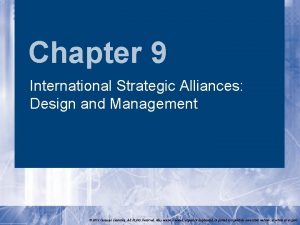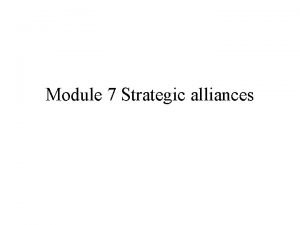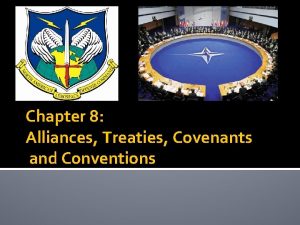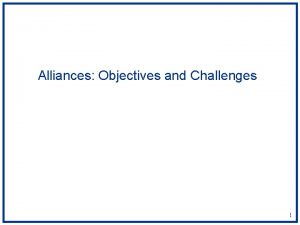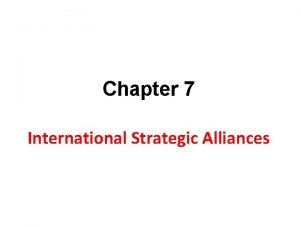Chapter 8 International Strategic Alliances Design and Management
























- Slides: 24

Chapter 8 International Strategic Alliances: Design and Management

Strategic Alliances Issues • Popular strategy to develop new product and to expand into new markets • However, strategic alliances are very risky and unstable • Failure rate of 30% to 60%

Where to Link in the Value Chain • Alliance combining same value-chain activities are to gain efficiencies, merge talents, or share risks • In operations alliances MNC combine manufacturing activities to reach economies of scale • Operations/marketing alliances provide access to markets

Choosing a Partner: The Most Important Choice? • A key criteria is strategic complementarity • Pick a partner with complementary skills that enhances but does not necessarily duplicate an alliance partner’s skills • Seek out compatible management styles • Seek a partner that will provide the “right” level of mutual dependency

Criteria for Choosing Partners • Avoid the “anchor” partner – one that holds back the strategic alliance because it cannot or will not provide its share of the funding • Be cautious of the “elephant-and-ant” complex that occurs when two companies are greatly unequal in size • Assess operating-policy differences with potential partners • Assess the difficulty of cross-cultural communication

Choosing an Alliance Type • Three main types of strategic alliances 1. Informal international cooperative alliances 2. Formal international cooperative alliances 3. International joint venture

1. Informal International Cooperative Alliance • Non-legally binding agreements between companies from two or more countries • Agreements of any kind • Provide links anywhere on their value chains • Limited involvement between companies

2. Formal Cooperative Alliances • Higher degree of involvement than informal alliances • Formal contract • Popular in high tech industries because of high costs and risks

3. International Joint Ventures (IJV) • Separate legal entity owned by two or more parent companies from different countries • No need for equal ownership • Equity based on cash or other contributions • Ex. : One partner brings technology while other partner brings financial contributions

Negotiating the Agreement • The formal agreement is not as important as the ability of managers to get along • IJV negotiation issues • equity contributions • management structure • “prenuptial” agreements

Organizational Design in Strategic Alliances • Depends on the type of alliance chosen • Informal ICAs often have no formal design issues • Formal ICAs may require separate organization unit housed in one company • IJV—Parent companies set up separate legal entity

Decision-making Control • Two areas need to be considered: • Operational decisions (focus on day to day running) • Strategic decisions (focus on long term survival) • Majority ownership does not necessarily control • In IJVs, strategic decision making takes place at the level of IJV’s board of directors or top

Management Structures • Dominant parent: controls or dominates strategic and operating decision making • Often has majority ownership • Treats the IJV as wholly owned subsidiary • Shared management: both parent companies contribute approximately the same number of managers to the alliance organization • Split control management control: partners usually share strategic decision making but split functional decision making

Management Structures (Cont. ) • Independent management structure: alliance managers act more like managers from a separate company • IJVs often recruit managers from outside the parent companies • Rotating management: key positions rotate among partners • Popular in developing countries • Serves to train management talent and transfer expertise to developing country

Choosing a Strategic Alliance Management Structure • If one partner has dominant equity position then: • Dominant management structure more likely • If partners have similar technologies or knowhow and contribute equally then: • Shared management structure preferred • If partners have different technologies but contribute equally then:

Human Resource Management in Strategic Alliances • HRM functions include recruiting and staffing for alliance positions • The HRM functions of an IJV are more complex • Managers (and sometimes workers) come from two or more firms or from two or more cultures

Critical HRM Problems and Issues • HRM planning: Must communicate to all employees the strategic intent of alliance. • Parent involvement: As alliances get older and larger, they tend to develop their own HRM practices. • Staffing the alliance management and technical personnel: Crucial and risky decision. Must not unload unwanted managers to alliance. • Staffing the alliance workforce: Assess local labor supply • Performance assessment: Needed for retention, promotion and salary decisions. Avoid adopting the system of one partner. • Loyalty: Managers may often feel dual loyalty to parent and to alliance • Career development: Must provide clear information on how alliance assignments fit within careers. Career ladder must exist within the IJV

Commitment and Trust • Commitment and trust go hand in hand • Commitment: putting forth extra effort to make the venture work and taking care of each other • Facets of commitment: • Attitudinal commitment: willingness to dedicate resources and efforts and face risks to make the alliance work • Calculative commitment: the practical side related to the alliance partner evaluations, expectations, and concerns regarding potential rewards from the relationship

Commitment and Trust • Trust: The confidence that the partner will deliver on the expected contributions to the alliance • Two types: • Credibility trust: confidence that the partner has the intent and ability to meet promised obligations and contributions to the alliance • Benevolent trust: confidence that the partner will behave with goodwill and with

Why Is Trust Important? • When there is no trust, partners hold back or take advantage of each other (Opportunistic Behavior). • Formal contracts can never identify all issues that will arise • Technology and knowledge also include tacit elements that can only be learned through trust.

Building and Sustaining Trust and Commitment • Pick your partner carefully • Know each side’s strategic goals • Seek win-win situations. Maintain a balance in which side gains from the alliance • Go slowly – problems will arise and take time to work out. • Invest in cross-cultural training • Invest in direct communication • Find the right levels of trust and commitment

Assessing the Performance of an International Strategic Alliance • If strategic intent is to produce immediate results, standard financial and efficiency measures can be used. (e. g. , profit center) • Some alliances provide indirect strategic benefits. • IJV and ICA performance criteria: • Often must include criteria other than financial, such as organizational learning.

If the Alliance Does Not Work • Negotiate an end or improve implementation • Know when to quit / invest more • Avoid “escalation of commitment” • Companies continue in an alliance longer than necessary because of financial and emotional investments. • Plan end—“prenuptial agreements” • Death not always failure. Some alliance are suppose to be short term

CONCLUSION • Alliances are important and will continue to grow • Key is to pick the right partner • Partners negotiate the structure that support their strategic intent • There must be agreement to HRM practices • Trust and commitment are basic foundations for successful alliances • Alliance performance is difficult to determine • Usually learning and market penetration can be used as performance measures
 Entry strategy and strategic alliances
Entry strategy and strategic alliances Horizontal strategic alliance
Horizontal strategic alliance Entry strategy and strategic alliances
Entry strategy and strategic alliances Entry strategy and strategic alliances
Entry strategy and strategic alliances Disadvantages of strategic alliances
Disadvantages of strategic alliances Industrial organization model of above average returns
Industrial organization model of above average returns Analysing the 6 strategic options megxit
Analysing the 6 strategic options megxit Global international issues in strategic management
Global international issues in strategic management Alliances and acquisitions
Alliances and acquisitions Global issues in strategic management
Global issues in strategic management Strategic compulsions
Strategic compulsions International strategic management process
International strategic management process Alliances wwi definition
Alliances wwi definition Cost of world war 1
Cost of world war 1 Types of functional alliances
Types of functional alliances Doctrines et alliances
Doctrines et alliances World war i combatants allies
World war i combatants allies Berlin wall
Berlin wall Sector skills alliances
Sector skills alliances Sap university alliances
Sap university alliances Alliances cartoon
Alliances cartoon Imperialism nationalism militarism alliances
Imperialism nationalism militarism alliances Alliance of three emperors 1881
Alliance of three emperors 1881 Puppy dog ploy
Puppy dog ploy Strategic fit vs strategic intent
Strategic fit vs strategic intent
